Serving 1,636 students in grades Kindergarten-12, Santa Rosa Academy ranks in the top 50% of all schools in California for overall test scores (math proficiency is top 50%, and reading proficiency is top 50%).
The percentage of students achieving proficiency in math is 38% (which is higher than the California state average of 33%). The percentage of students achieving proficiency in reading/language arts is 55% (which is higher than the California state average of 47%).
The student:teacher ratio of 21:1 is equal to the California state level of 21:1.
Minority enrollment is 64% of the student body (majority Hispanic), which is lower than the California state average of 80% (majority Hispanic).
Quick Stats (2025)
- School Type: Charter School
- Grades: Kindergarten-12
- Enrollment: 1,636 students
- Student:Teacher Ratio: 21:1
- Minority Enrollment: 64%
- Graduation Rate: ≥95% (Top 20% in CA)
- Overall Testing Rank: Top 50%
- Math Proficiency: 38% (Top 50%)
- Reading Proficiency: 55% (Top 30%)
- Science Proficiency: 42% (Top 30%)
- Source: National Center for Education Statistics (NCES), CA Dept. of Education
Top Rankings
Santa Rosa Academy ranks among the top 20% of public schools in California for:
Category
Attribute
Graduation Rate
School Overview
Santa Rosa Academy's student population of 1,636 students has grown by 5% over five school years.
The teacher population of 79 teachers has grown by 9% over five school years.
School Type
Grades Offered
Grades Kindergarten-12
Total Students
1,636 students
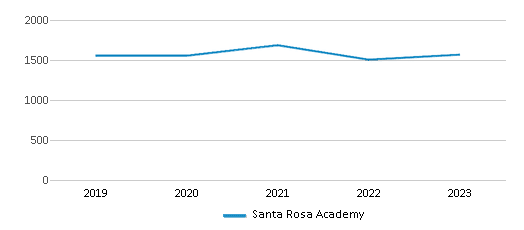
Gender %

Total Classroom Teachers
79 teachers
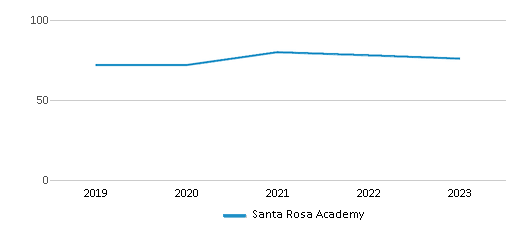
Students by Grade
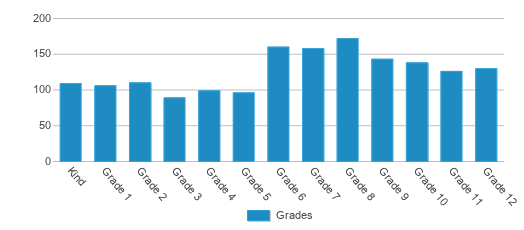
School Rankings
Santa Rosa Academy ranks within the top 50% of all 9,602 schools in California (based off of combined math and reading proficiency testing data).
The diversity score of Santa Rosa Academy is 0.65, which is more than the diversity score at state average of 0.63. The school's diversity has stayed relatively flat over five school years.
Overall Testing Rank
#3040 out of 9602 schools
(Top 50%)
(Top 50%)
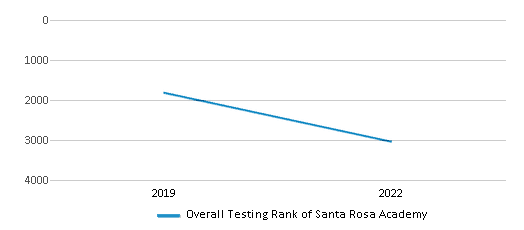
Math Test Scores (% Proficient)
38%
33%

Reading/Language Arts Test Scores (% Proficient)
55%
47%
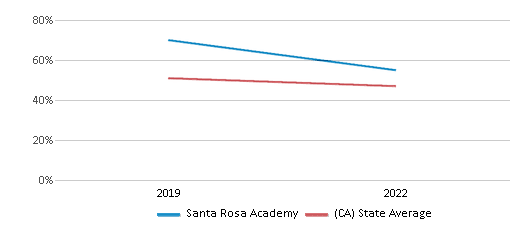
Science Test Scores (% Proficient)
42%
29%
Student : Teacher Ratio
21:1
21:1
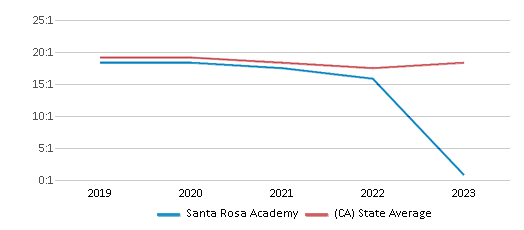
American Indian
1%
1%
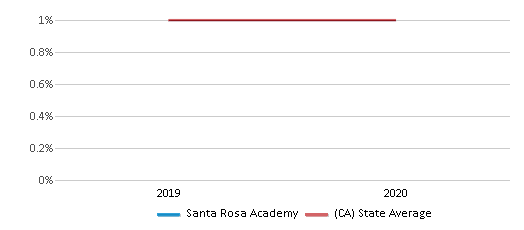
Asian
6%
12%
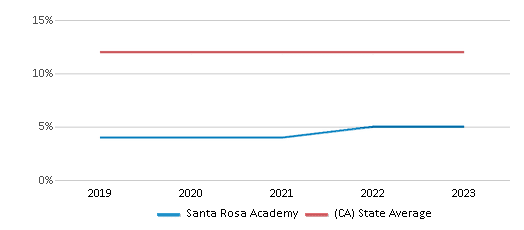
Hispanic
47%
56%

Black
4%
5%
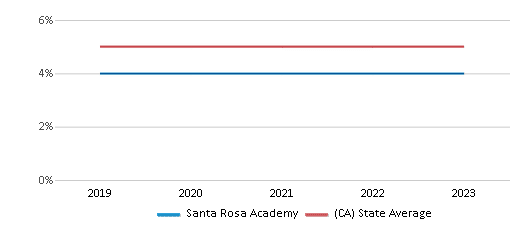
White
36%
20%
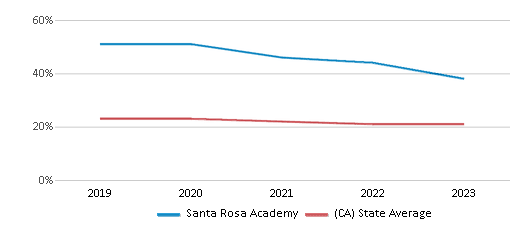
Hawaiian
n/a
n/a
Two or more races
6%
6%
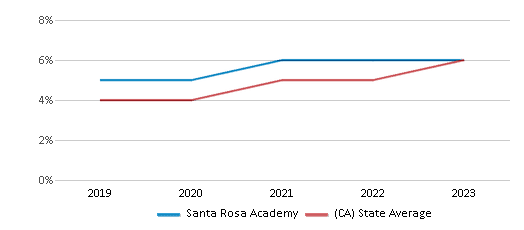
All Ethnic Groups
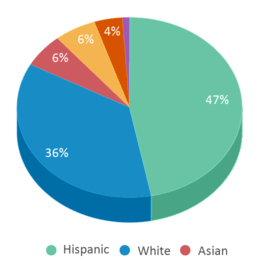
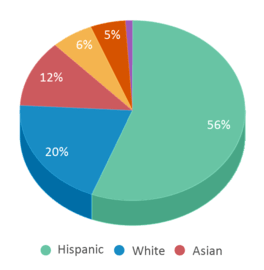
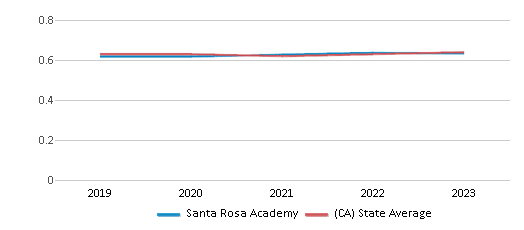
Graduation Rate
≥95%
87%
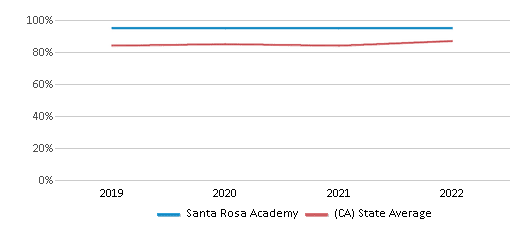
Eligible for Free Lunch
27%
54%
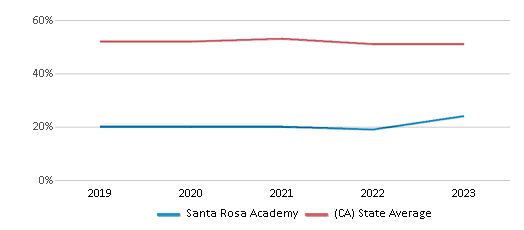
Eligible for Reduced Lunch
1%
8%
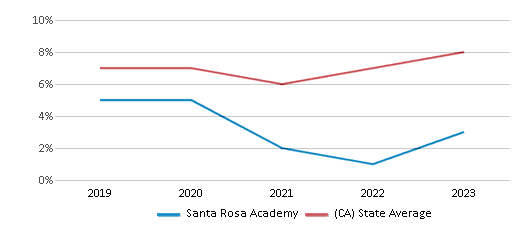
School Statewide Testing
School District Name
Source: National Center for Education Statistics (NCES), CA Dept. of Education
Profile last updated: 02/09/2025
Frequently Asked Questions
What is Santa Rosa Academy's ranking?
Santa Rosa Academy is ranked #3040 out of 9,602 schools, which ranks it among the top 50% of public schools in California.
What schools are Santa Rosa Academy often compared to?
Santa Rosa Academyis often viewed alongside schools like Nuview Bridge Early College High School by visitors of our site.
What percent of students have achieved state testing proficiency in math and reading?
38% of students have achieved math proficiency (compared to the 33% CA state average), while 55% of students have achieved reading proficiency (compared to the 47% CA state average).
What is the graduation rate of Santa Rosa Academy?
The graduation rate of Santa Rosa Academy is 95%, which is higher than the California state average of 87%.
How many students attend Santa Rosa Academy?
1,636 students attend Santa Rosa Academy.
What is the racial composition of the student body?
47% of Santa Rosa Academy students are Hispanic, 36% of students are White, 6% of students are Asian, 6% of students are Two or more races, 4% of students are Black, and 1% of students are American Indian.
What is the student:teacher ratio of Santa Rosa Academy?
Santa Rosa Academy has a student ration of 21:1, which is equal to the California state average of 21:1.
What grades does Santa Rosa Academy offer ?
Santa Rosa Academy offers enrollment in grades Kindergarten-12
What school district is Santa Rosa Academy part of?
Santa Rosa Academy is part of Santa Rosa Academy School District.
School Calendar
View the Santa Rosa Academy yearly calendar below. Note key dates such as:
Event
Date
Spring Break Recess - No School (Main Campus)
April 14, 2025 (Monday)
Last Day of School (Main Campus)
May 30, 2025 (Friday)
School Reviews
3 8/28/2021
I currently go to Santa Rosa Academy and am in 9th grade. The lack of teachers is scary, there are always substitutes and, I haven''t had all my actual teachers for a singular day, not even the first day. When you have a sub you can barely learn anything because all there given is a lesson plan. The School requires you to wear uniforms which are just an overall drag. During lunch, some employees and teachers for the school are very rude and will try to get you detention for anything you do.
5 1/18/2013
This schools centers on a students success. Many extracurricular activities and classes with mostly firm but friendly teachers help out in the path to success. WARNING this school has a very strict strike policy... three large offenses (from not wearing proper uniform to not completing work) will result in expulsion. Very strict school but has very high academics (to my opinion). Recommend for those students looking for a challenge and a good education.
Review Santa Rosa Academy. Reviews should be a few sentences in length. Please include any comments on:
- Quality of academic programs, teachers, and facilities
- Availability of music, art, sports and other extracurricular activities
Recent Articles

What Is A Charter School?
Explore the world of charter schools in this comprehensive guide. Learn about their history, how they operate, and the pros and cons of this educational innovation. Discover key facts about charter schools, including admission policies, demographics, and funding, as well as what to look for when considering a charter school for your child.

10 Reasons Why High School Sports Benefit Students
Discover the 10 compelling reasons why high school sports are beneficial for students. This comprehensive article explores how athletics enhance academic performance, foster personal growth, and develop crucial life skills. From improved fitness and time management to leadership development and community representation, learn why participating in high school sports can be a game-changer for students' overall success and well-being.

February 05, 2025
Understanding the U.S. Department of Education: Structure, Impact, and EvolutionWe explore how the Department of Education shapes American education, from its cabinet-level leadership to its impact on millions of students, written for general audiences seeking clarity on this vital institution.









